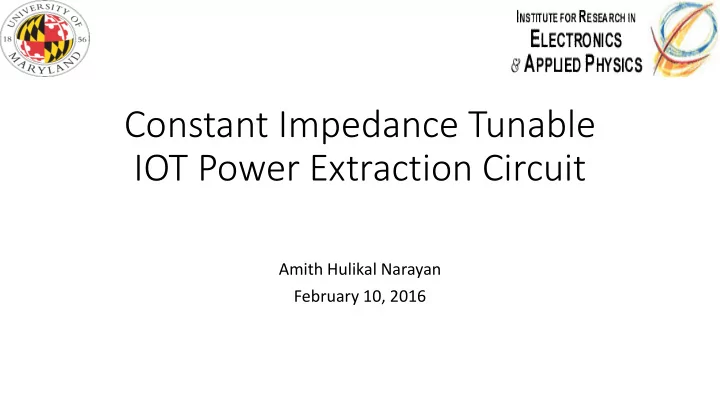

Constant Impedance Tunable IOT Power Extraction Circuit Amith Hulikal Narayan February 10, 2016
Presentation Outline • Need for Power Extraction Circuit: Why and Where? • Constant Impedance Tunable Circuit • Experiments with Transformers of different Coupling Coefficients • Measurements & Comparison for one of the transformers • Improvements: Tunable Circuit, Shielded Box, Better Transformer • Transformer Designs for Improving the Coupling Coefficient • Conclusion
Why and Where do we need the Power Extraction Circuit ? Gap Ceramic Gap • Resonant circuit in an IOT extracts the kinetic energy of the modulated electron beam converting it into electromagnetic energy. • The broad frequency range requires the circuit to be tunable. • Need for a frequency independent decelerating voltage requires constant impedance. • Connected parallel to the gap electrically in the IOT.
Constant Impedance Circuit 1 • Resonant Frequency, 𝜕 0 = 𝑀 0 𝑂 2 𝐷 𝑞 +𝑁 2 𝐷 𝑡 𝑂 2 • Gap Impedance, 𝑎 = 𝑎 0 𝑁 2 𝑎 0 • Quality factor, 𝑅 = 𝜕 𝑝 𝑀 0 𝑁 2 𝑅 • Combining these gives, 𝐷 𝑞 = 𝜕 𝑝 𝑎 ⇒ Changing resonant frequency , changes Quality Factor • ⇒ Changing resonant frequency , requires changing • Capacitance on the primary side . • Quality factor varies from 5 – 60 • Capacitance varies from 10 pF – 1 nF • Inductances on primary and secondary are constant.
Constant Impedance Circuit • Anticipated Beam Voltage: 70 kV • Peak Beam current: 15 A • Gap impedance: 9.8 k Ω • Deceleration achieved: 66 kV • As resonant frequency changes, gap impedance is mostly constant at the resonant peaks assuming perfectly coupling. • As frequency is changed, capacitor on the primary side is tuned to keep the gap impedance constant.
Experiments with Transformers of different Coupling Coefficients k = 0.29 k = 0.38 k = 0.46 k = 0.70
Measurements & Inferences for the circuit with a transformer of k = 0.70 Gap impedance measurements showed • leftward shift of resonance peak in comparison with the simulation model. Parasitic capacitances/lead inductances in • the bench circuit shown above were responsible for shift in resonant frequencies. Need to isolate the circuit from all such • parasitic effects
Improvements: Tunable Circuit, Shielded Box, Cooling Pipes & Better Transformer • The entire circuit to be housed inside a copper box to shield it from all types of parasitic capacitances/lead inductances. • Tunable capacitors to be used instead of handmade fixed capacitors. • Transformer model with appropriate turns ratio, is designed and machined. • Water cooling mechanism for Water Cooling Pipes transformer coils are incorporated.
Transformer Designs for Improving the Coupling Coefficient Model 1 Model 2 Model 3
Model – 1, Coupling Coefficient, k= 0.476 • Red is primary, Green is Secondary. • Coefficient of Coupling: 0.476 • L(primary) = 25.838 uH • L(secondary) = 1.0569 uH • L(mutual) = 2.4977 uH • N:M = 11:1
Model – 2, Coupling Coefficient k= 0.646 • Secondary coil made of copper sheets completely covering primary coils to reduce flux leakage. Red is Primary and Yellow is Secondary. • Coefficient of Coupling: 0.646 • L(primary) = 25.855 uH • L(secondary) = 566.942 nH • L(mutual) = 2.3207 uH • N:M = 11:1
Model – 3, Coupling Coefficient k= 0.714 • Secondary coils (11) connected in parallel to increase the flux linkage with primary coils • Coefficient of Coupling: 0.714 • L(primary) = 25.833 uH • L(secondary) = 437.914 nH • L(mutual) = 2.4037 uH • N:M = 11:1
Conclusion & Further Work • Coupling coefficient as we speak is at 0.71. Need to achieve values closer to 1. • Parasitic/stray capacitances and lead inductances changes the resonant frequency of circuits. Circuit isolation to be achieved by using a copper box. • A stable feedback circuit to constantly adjust or tune the capacitor on the primary side needs to be designed. • Simulations predict the primary inductance to be a good match with design. Need to measure the same in the experiment.
Recommend
More recommend